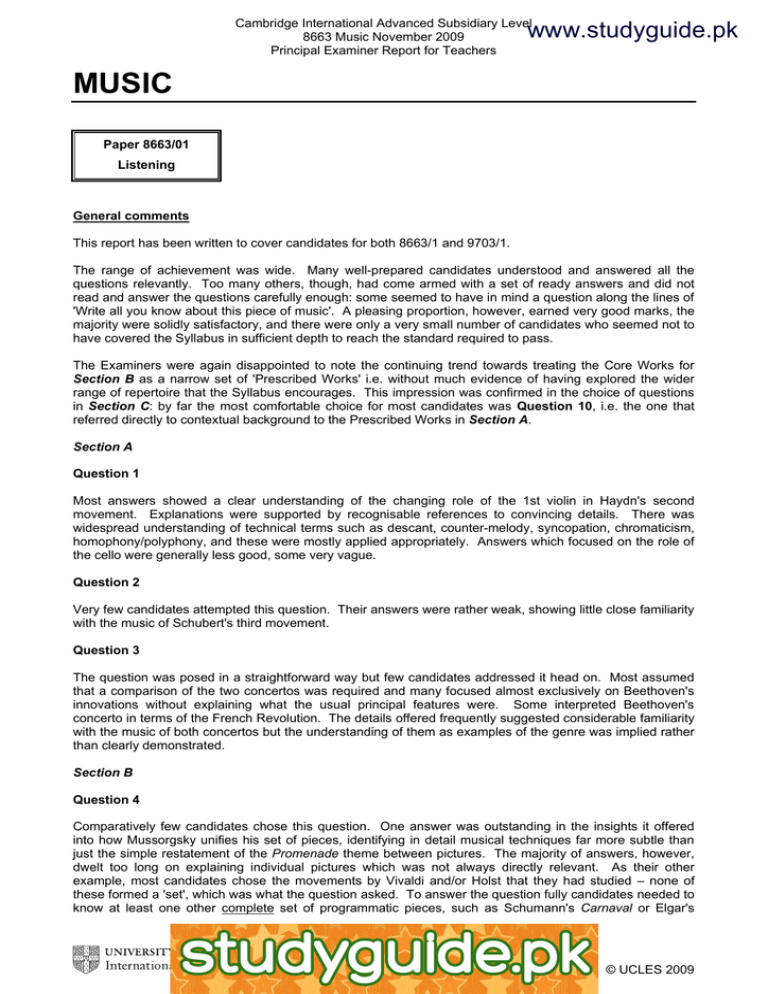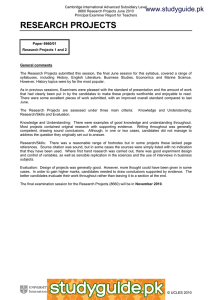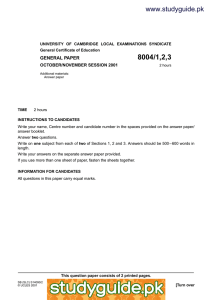MUSIC www.studyguide.pk
advertisement

Cambridge International Advanced Subsidiary Level 8663 Music November 2009 Principal Examiner Report for Teachers www.studyguide.pk MUSIC Paper 8663/01 Listening General comments This report has been written to cover candidates for both 8663/1 and 9703/1. The range of achievement was wide. Many well-prepared candidates understood and answered all the questions relevantly. Too many others, though, had come armed with a set of ready answers and did not read and answer the questions carefully enough: some seemed to have in mind a question along the lines of 'Write all you know about this piece of music'. A pleasing proportion, however, earned very good marks, the majority were solidly satisfactory, and there were only a very small number of candidates who seemed not to have covered the Syllabus in sufficient depth to reach the standard required to pass. The Examiners were again disappointed to note the continuing trend towards treating the Core Works for Section B as a narrow set of 'Prescribed Works' i.e. without much evidence of having explored the wider range of repertoire that the Syllabus encourages. This impression was confirmed in the choice of questions in Section C: by far the most comfortable choice for most candidates was Question 10, i.e. the one that referred directly to contextual background to the Prescribed Works in Section A. Section A Question 1 Most answers showed a clear understanding of the changing role of the 1st violin in Haydn's second movement. Explanations were supported by recognisable references to convincing details. There was widespread understanding of technical terms such as descant, counter-melody, syncopation, chromaticism, homophony/polyphony, and these were mostly applied appropriately. Answers which focused on the role of the cello were generally less good, some very vague. Question 2 Very few candidates attempted this question. Their answers were rather weak, showing little close familiarity with the music of Schubert's third movement. Question 3 The question was posed in a straightforward way but few candidates addressed it head on. Most assumed that a comparison of the two concertos was required and many focused almost exclusively on Beethoven's innovations without explaining what the usual principal features were. Some interpreted Beethoven's concerto in terms of the French Revolution. The details offered frequently suggested considerable familiarity with the music of both concertos but the understanding of them as examples of the genre was implied rather than clearly demonstrated. Section B Question 4 Comparatively few candidates chose this question. One answer was outstanding in the insights it offered into how Mussorgsky unifies his set of pieces, identifying in detail musical techniques far more subtle than just the simple restatement of the Promenade theme between pictures. The majority of answers, however, dwelt too long on explaining individual pictures which was not always directly relevant. As their other example, most candidates chose the movements by Vivaldi and/or Holst that they had studied – none of these formed a 'set', which was what the question asked. To answer the question fully candidates needed to know at least one other complete set of programmatic pieces, such as Schumann's Carnaval or Elgar's www.xtremepapers.net 1 © UCLES 2009 Cambridge International Advanced Subsidiary Level 8663 Music November 2009 Principal Examiner Report for Teachers www.studyguide.pk Enigma Variations. Either of these would have offered a straightforward, easy to explain, contrast with the Mussorgsky. Question 5 Although this was a popular choice, on the whole it was not answered well. A few candidates were able to argue a view sensibly but the 'range of examples' was often narrow or lacking in specific detail. Only one candidate referred to music that lay outside the Core Works. A number of candidates answered a quite different question by comparing only what a solo piano can do with the potential of an orchestra. Many misused the word 'tonality' i.e. as a reference to instrumental 'tone-colour'. Question 6 There were few convincing answers to this question. Several candidates limited their discussion to arrangements, again comparing the piano and orchestral versions of Pictures at an Exhibition in detail. Some discussed influences, such as that of Mars on music for films such as Star Wars, but few mentioned direct use in advertisements. Section C Question 7 Very few answers addressed the question in terms of what makes a good tune, Most interpreted it as a question about the performance of melodies, the instruments used, the accompaniment, the vocal style, taking the existence of the melody itself for granted. Several asserted the need for a melody to be 'catchy' but nearly all avoided the task of defining how this could be achieved. Question 8 This was the least-favoured question in this section of the paper. It was usually answered in terms of those composers who have natural talent and have, apparently, no need to learn, versus those for whom hard graft is required. Question 9 Although there were some interesting accounts of different traditions few candidates went on to wrestle with the issue of contemporary influences on them. Question 10 This was by far the most popular question. Most candidates understood the essential differences – live/recorded music, employed/independent musicians. Some were able to explore these issues in greater depth, often showing a good knowledge of social conditions and mature reflection on their implications. www.xtremepapers.net 2 © UCLES 2009 Cambridge International Advanced Subsidiary Level 8663 Music November 2009 Principal Examiner Report for Teachers www.studyguide.pk MUSIC Paper 8663/06 Investigation and Report At the AS Level (8663), in some cases candidates submitted work that was clearly the product of a taught course which all members of the group had followed in common. This goes against the principal aim of the Component: that candidates show how far they are able to investigate independently and apply skills learned studying Component 1 in explaining music of their own choice. Nonetheless, several candidates produced very convincing Reports that reflected extensive and thoughtful Investigations carried out over a sustained period of time. A few were outstandingly mature in breadth of repertoire known and depth of informed discussion. These were usually the candidates who had used the component as an opportunity to explore, and immerse themselves in, a body of music which they already knew well and had been keen on for some time. Their first-hand knowledge of the music was evident in the detail of their discussion of a wealth of examples, each carefully chosen for the significance of the technique or effect being demonstrated. A few candidates, however, wrote (very coherent) whistle-stop tours of the history of a genre or tradition, which they had gone to great lengths to illustrate with copious short audio examples. But these musical examples were only incipits that identified e.g. a song from a 1920s musical – they were not discussed and had not been selected to demonstrate specific features of the music of that time. Others who had tried to cover too much found themselves confused and drowning under the mass of material they had collected. This is now a growing problem, a direct result of the ease of access to and availability of so much information (often of very high quality) on the web. While the Examiners are sympathetic towards candidates for whom English may not be their first language, reproducing phrases and sentences, even whole paragraphs in some cases, from the Internet, because it appears to express more articulately what the candidate wants to say, must be discouraged. At the very least it prevents the candidate demonstrating that they have assimilated what they have read (because Examiners quickly recognise what are the candidate's own words and what is 'borrowed'): at the worst it is actual plagiarism and the candidate risks disqualification. A collage of quotations is not convincing evidence of a secure understanding. www.xtremepapers.net 3 © UCLES 2009




